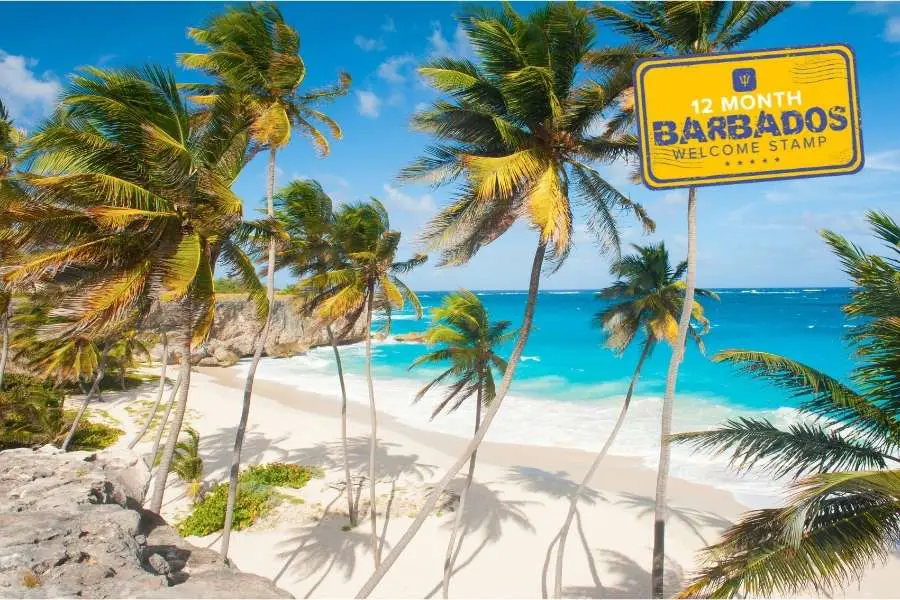Table of Contents
ToggleAs digital nomads, we have the great freedom to move our location at any time. Even though I appreciate a (temporarily) fixed residence, I have found myself moving to a few hotspots over the past few years. Not least because of the workations we have regularly hosted in countries with tropical temperatures since 2015.
Besides sunshine and a low cost of living, what’s important to most of us are, of course, the working conditions on-site. A good internet connection, enough coworking spaces or cafés and a community of like-minded people play a big role.
So how do we find the places in the world that are perfect for both living and working?
There are already really good resources that show you the best cities for digital nomads. At the top of the list is the Nomad List. The site is really great, although I sometimes have my doubts about the accuracy of the data – Berlin with monthly costs of almost 3,000 USD and Ubud in Bali with one of the worst internet connections of all the cities compared make me doubt it.
I prefer personal tips, which are of course always subjective. For me, quite different criteria are probably more decisive than for you. That’s exactly why this location guide not only contains my favourites but also hard facts and tips from experienced digital nomads.
I’ve enlisted the help of some veteran digital nomads. They not only told me what their hotspots are, but also what matters to them when choosing a location. According to these most important criteria, I have compared various locations in terms of their nomadic suitability.
The location guide consists of three parts, from which you can simply pick out what is important to you in order to find the perfect place for your workation:
Country comparison according to fixed criteria
Countries are compared according to eight criteria that emerged as important from the survey of digital nomads.
Top 25 places for digital nomads
The results of the country comparison and the tips from our experienced nomads have resulted in a list of the 25 hotspots.
Tips from digital nomads
18 experienced digital nomads each tell you their three hotspots and why you should see them.
Criteria for a good place to be from a digital nomad’s point of view
Before you decide to pitch your tents somewhere for several weeks or even months, you should think carefully about what you expect from this place. If you have your laptop with you, you will not only want to relax but also need a productive working environment.
To be able to work properly on-site, you need a certain infrastructure. This includes coworking spaces or cafés with reliable internet as a place to work, as well as easy transport and affordable flats.
In addition to good working conditions, the leisure facilities, proximity to the beach and nature, as well as the weather, are of course also decisive for our mood. The more comfortable we feel in a place, the more motivated we are to tackle our projects. At least that’s how it is for me.
A final important point for the right work mindset is a community of like-minded people on site. Working together with other digital nomads is incredibly motivating and inspiring. Without the community, there is no exchange among each other and loneliness remains.
In order to objectify these (my) criteria for a good nomad hotspot, I asked long-time digital nomads which points are decisive for them when choosing a location.
I can only agree with the majority here. In addition to good food, sunshine, sufficient leisure activities and an open culture, reliable internet and a community of like-minded people are especially important.
The location guide for digital nomads is based precisely on these criteria. We take a look at which cities and countries score best on the individual criteria before selecting the top 25 hotspots based on them.
You should decide for yourself where your priorities lie when choosing a location. Is fast internet more important to you than proximity to the beach? Do you prefer to live as cheaply as possible and can do without the community? Find your perfect location for the next workation from the following comparisons.
Cost of living
Costs are clearly one of the most important issues for us as location-independent entrepreneurs. Income is independent of where we live, but expenses are. This means that we have more left at the end of the month if we spend less while our income remains the same.
The principle, also known as geo-arbitrage, is one of the very big advantages for digital nomads. You can see in which places you can live well with little income earned independently of location, for example, by looking at the “Cost of Living Index”. This figure is a relative indicator for prices of consumer goods and rents in a country.
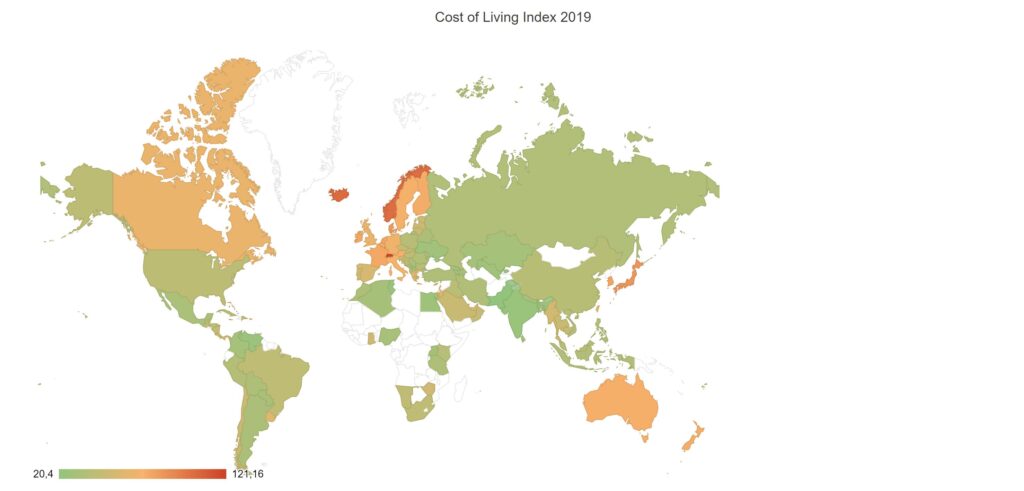
The Cost of Living Index refers to the cost of living in New York (a CoL of 80 means that it is on average 20% cheaper in this country than in New York). The data comes from the user-based platform Numbeo, where hundreds of thousands of price quotes are constantly updated.
Of course, the cost of living sometimes differs drastically between different places in a country. I am thinking, for example, of a comparison between Munich and Berlin or Chiang Mai and Bangkok.
That’s why the following table gives you a comparison of the average cost of living in over 200 cities worldwide. You’ll find average prices for one-room flats in the city centre and in the suburbs, as well as everyday expenses such as a cheap meal, a bottle of water, taxi fares and petrol prices.
The cost of living is particularly cheap in cities on the Indian subcontinent, in North Africa, Southeast Asia and Latin America. Some digital nomad favourites such as Chiang Mai, Medellin, Cebu and Ho Chi Minh City top the list, proving that cost is one of the main criteria for choosing a location. Check prices here on Numbeo.
Community
The right people around you are at least as important as the costs. The spirit in a place can be super motivating, or it can cause productivity to plummet.
A sufficiently large community with other digital nomads is not only important to get into the right mindset, but above all to benefit from the exchange with like-minded people. How many people in your circle of acquaintances at home already understand what you do?
The big problem is that there is no central point of contact for us digital nomads yet. On interactive maps like those of Where my Nomads at or in Citizen Circle, you can see where a few people are, but there is a lack of mass.
Similarly, on Meetup.com or Startup Travels you can find events for entrepreneurs as well as simply interesting people, but it is difficult to conclude from this how large the community is in a place.
The indicator with the greatest significance comes from the Nomad List. Well over 10,000 digital nomads are registered in the associated community and have indicated their current location. This gives us at least a rough idea of which places were popular in 2017.
For Germans, Latin America and Southeast Asia are at the top of the list in the winter months, especially Chiang Mai and Bangkok in Thailand, Medellin in Colombia, Ho Chi Minh City in Vietnam and Buenos Aires in Argentina, as well as Berlin, Barcelona and Lisbon in Europe.
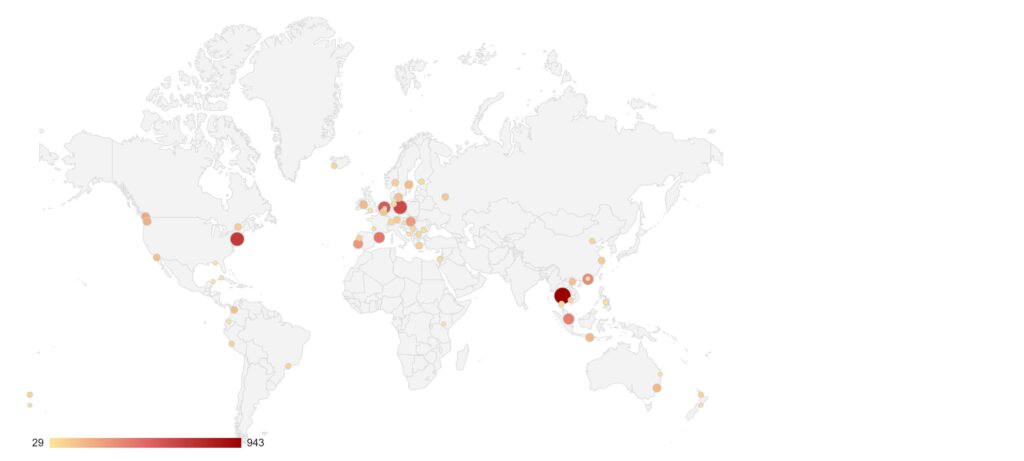
The data comes from the Nomad List and shows how many other digital nomads registered in the Nomads community reported having been in each location by August 2017. However, these figures are only meaningful to a limited extent.
Internet
In my small survey, the factor “reliable and fast internet” was an important criterion for the choice of location for 16 out of 18 respondents. This makes sense, of course, since without the internet the digital nomad would only be an analogue nomad.
If you’ve travelled the world with a laptop and smartphone and worked on the road, you know how frustrating poor internet connections and constant power outages can be. It’s a good thing that even smaller developing countries are way ahead of Germany, at least when it comes to mobile internet.
With its Speedtest app, the company Ookla not only has a helpful tool for measuring one’s own internet speed, but also regularly publishes the data collected from millions of users in the Speedtest Global Index. Akamai offers another good database for the current internet speed in all corners of the world.
By far, the fastest broadband internet in 2019 is in the Asian metropolises of Singapore (195 Mbit/s download rate) and Hong Kong (165 Mbit/s). When it comes to mobile internet, Norway (67 Mbit/s), Canada (65 Mbit/s) and Holland (60 Mbit/s) are ahead. Germany, by the way, has made it to 43rd place with 68 Mbit/s for broadband connections and 30th place for mobile internet with 31 Mbit/s. There is hope.
Of the most popular hotspots for digital nomads, only Malaysia (64 Mbit/s) and Thailand (59 Mbit/s) made it into the top 50 for mobile internet speed. The Philippines, Indonesia and India are at the bottom of the list. In general, Latin American countries in particular still have a lot of catching up to do in terms of fast internet connections.
In these countries, a SIM card with data volume can be a good alternative, even if the mobile internet does not quite reach the speed of a broadband connection (the global average is about half as fast). To find out how to get online anywhere in the world, read this article.
The map below shows the internet speed for broadband connections in different countries. For reference, the global average in 2019 was a download speed of 55 Mbps and upload speed of 27 Mbps.
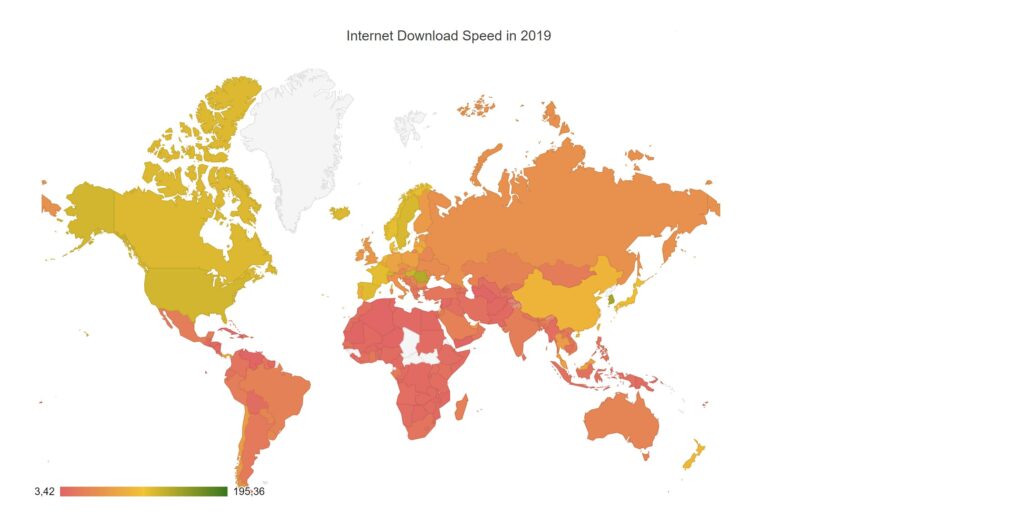
The data on internet speed is from March 2019 and comes from Ookla’s Speedtest Global Index, which extracts and processes data from around 5 million speed tests conducted by users every day.
Weather
What does a digital nomad need to be happy besides a good internet connection? Of course, sunshine, preferably all year round. This is precisely why many nomads migrate to warmer climes over the winter.
As a rule, of course, the closer you get to the equator, the warmer the temperatures. The average temperature near the equator is between 25 and 35 degrees Celsius. To cool down a bit, head to higher places like La Paz and Cusco or cities that get a fresh sea breeze.
No wonder, then, that the digital nomads’ favourites are almost without exception within 15 degrees of latitude around the equator. So in these places, besides a well-functioning air-conditioning system, you only have to worry about the rainy seasons.
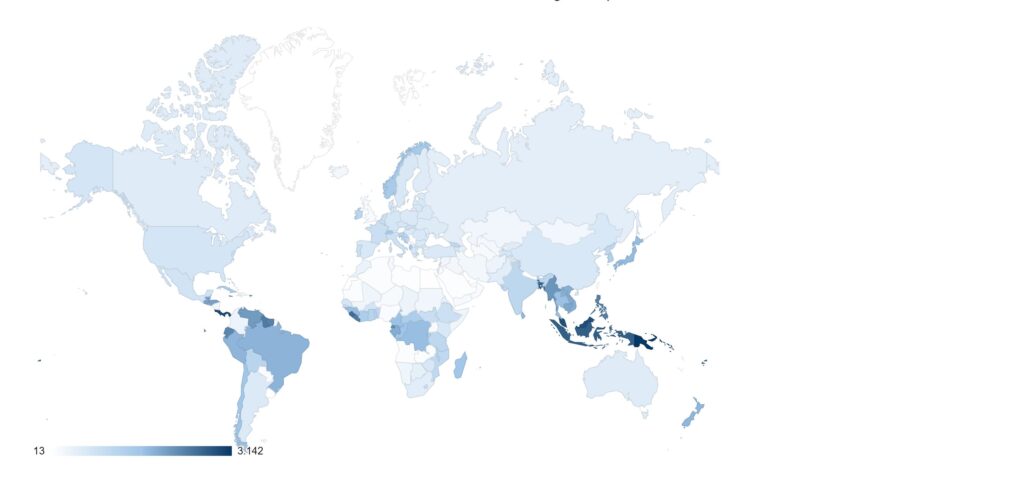
This map shows the annual average rainfall (in mm) for selected countries between 2010 and 2014. The data comes from the archives of the World Bank.
As you can easily see, tropical countries not only have the highest temperatures, but also the highest rainfall. 90% of the rain falls in the respective rainy seasons, which can sometimes last up to five months.
So it makes sense to find out about the rainy season before you go, as it varies from country to country. Affected regions are mainly Southeast Asia, northern Australia, Central America and parts of Central Africa.
As a general rule, you can assume that the main rainy seasons in Vietnam, Thailand, the Philippines and Central America last from June to October and in Central Africa, Brazil, Peru, Malaysia and Indonesia from November to April. However, there are differences depending on the region. A good overview can be found on this page.
Happiness and quality of life
Happy people around you are at least as important for your mood as the weather. How happy people are in a country depends (depending on the study) on the quality of life offered, health care, income and environmental factors.
For myself, I can clearly say that the attitudes of the people around me have a big impact on my work ethic and my general mood. To compare different countries according to these factors, let’s look at two indices.
The Happy Planet Index (HPI) does not look at economic variables, but compares countries on a scale between 0 and 100, based on life expectancy, the country’s ecological footprint and the sustainable well-being of the population. In addition, the inequalities of the various indicators within a country are included in the index.
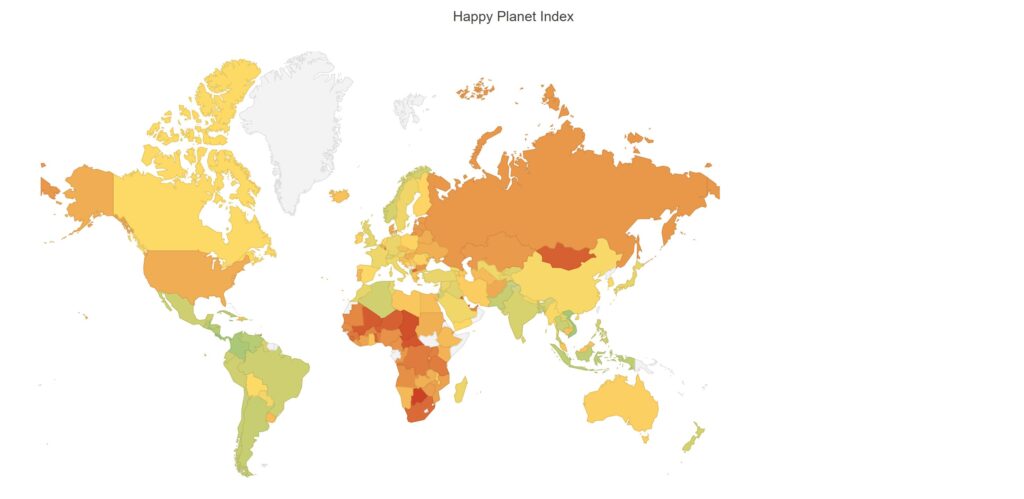
The HPI (Happy Planet Index) takes into account life expectancy (data from UNDP), the well-being of the population (survey on a scale of 0-10) and the ecological footprint of a country (data from WWF). The data comes from 2016
Another good indicator of the quality of life in a country is the Life Quality Index. This takes into account various factors that affect the physical and mental well-being of the population.
Unlike the Happy Planet Index, more measurable factors such as purchasing power, the ratio of income to prices, cost of living, traffic, air quality, medical care and safety play a role here. Therefore, there are differences between the two indices, suggesting that a supposedly high quality of life alone (such as in Australia, Europe and North America) does not make people happy.
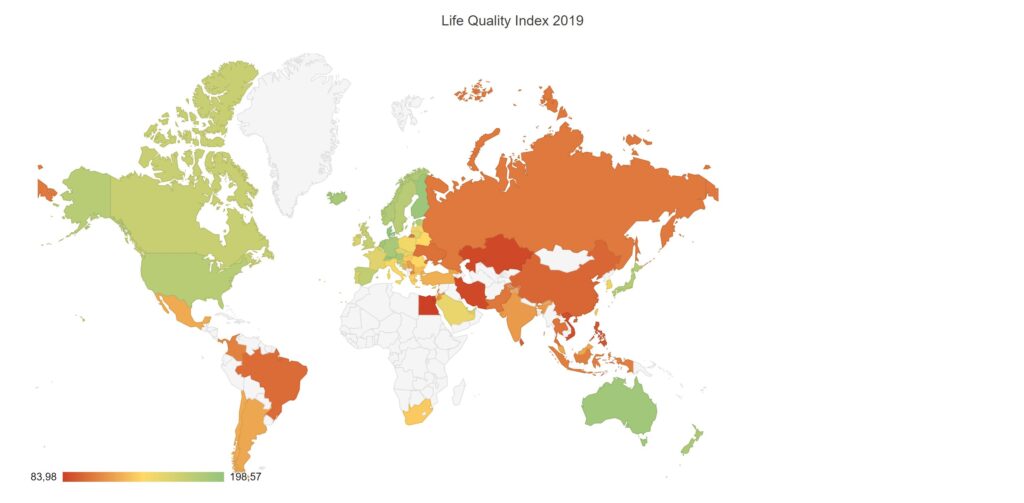
Included in Numbeo’s Life Quality Index are the factors of purchasing power, cost of living, safety, medical care, air quality and the traffic situation. All figures are from 2019.
I would like to mention air and water pollution separately. Having lived in China for four years, I know how polluted air can limit the quality of life.
In some countries, air pollution is also seasonal, for example during the Burning Season in spring in Thailand, where burnt fields cast a grey veil over the cities.
Language and culture
An important part of any culture is the language. Take the time to learn at least a few words of the local language. Not only to communicate locally, but to understand local conditions and immerse yourself more deeply in the culture.
Plus, learning a new language keeps your mind sharp and earns you recognition (and better prices) from locals. If you are just passing through or lack the time and motivation to learn the language, then it makes sense to look at your English skills in the destination country as a criterion beforehand.
A good indicator is the EF English Proficiency Index from Education First. The company collects data from free online tests for different countries and ranks them.
Since it is disputed how representative EF’s index is, the following map uses data from the worldwide Wikipedia community that they have collected for individual countries from various sources.
In the map, you can see that in many Asian countries you can get by quite well with English. The problem arises when you are away from the big cities and hotspots for digital nomads. In Central and South America, you are well served if you speak at least a few words of Spanish.
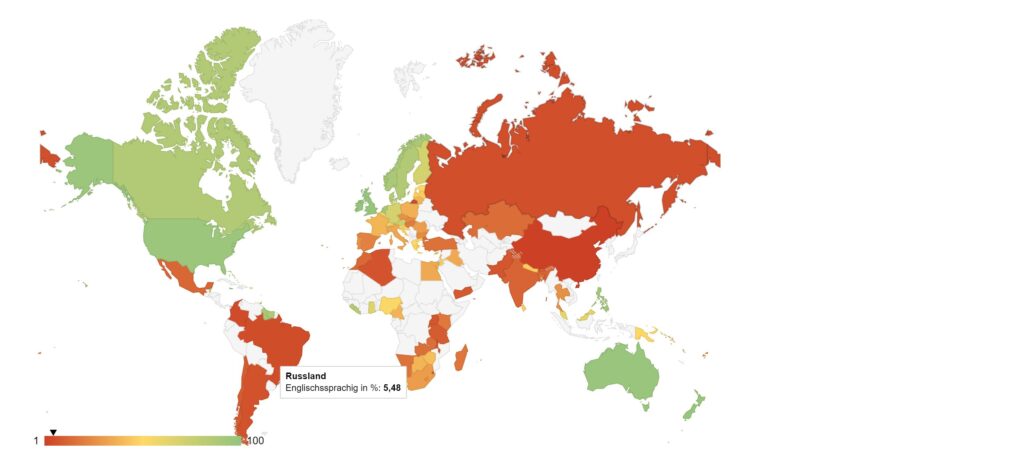
This map shows the percentage of the English-speaking population in each country. The data comes from various sources and was compiled on Wikipedia.
In addition to language barriers, cultural differences can also take a lot of getting used to. There are cultures that are more open to foreign visitors and those that are less enthusiastic.
Have you ever been to a country where you didn’t feel welcome at all? For me, it has been the exception, but it has happened. In these countries, I can’t imagine being part of the local culture for a long time.
In surveys conducted by the World Economic Forum, the attitude of locals was measured on a scale from 1 (not hospitable) to 7 (very hospitable). Of course, this index should be taken with a grain of salt, as hospitality can be subjective. Generally speaking, you will always be well-received if you yourself are open and friendly.
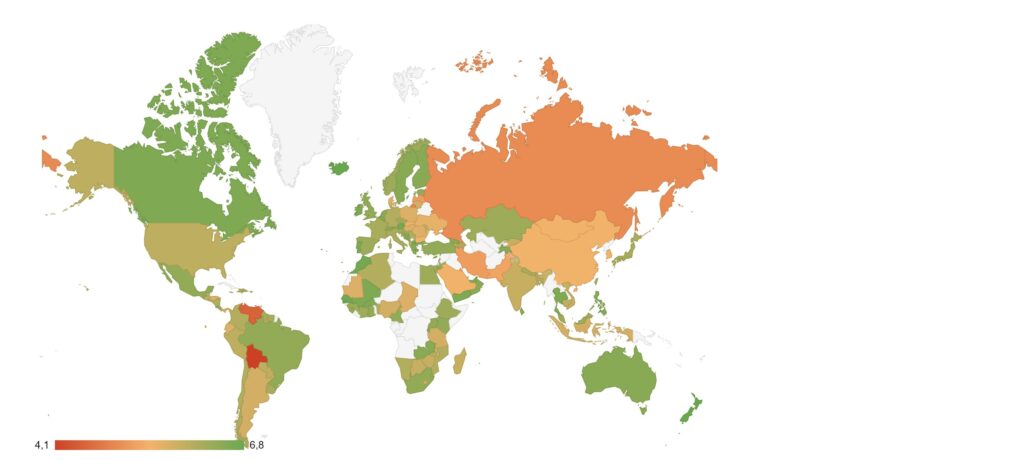
This index comes from the World Economic Forum’s Travel and Tourism Competitiveness Report and examines the hospitality of a country’s population towards foreign visitors. The data collected comes from surveys and local sources from 2017.
Infrastructure
The infrastructure includes leisure facilities, transport and the availability of flats and jobs. Basically, everything that can make life on-site pleasant or stressful.
You can find your local workspace either in a coworking space or a café with good wifi. Great resources for finding these places are Sharedesk for coworking spaces and generally for wifi spots the app Wifi Finder.
The best way to find a temporary flat is through Airbnb. If you’re staying longer than a month, check out Facebook groups or local listings for flats (e.g. Gumtree).
In my opinion, a very good indicator of the infrastructure of a country is the traffic situation. Not only does it give you a good indication of how easy it is to get around, but it also gives you a good idea of the level of congestion you will face locally.
The map below shows the Traffic Index, which measures the efficiency of a country’s transport system. Predominantly red colours in Southeast Asia and Latin America mean that the transport system in these regions is more likely to cause frustration. You should be aware of this, but also not let it influence you too much.
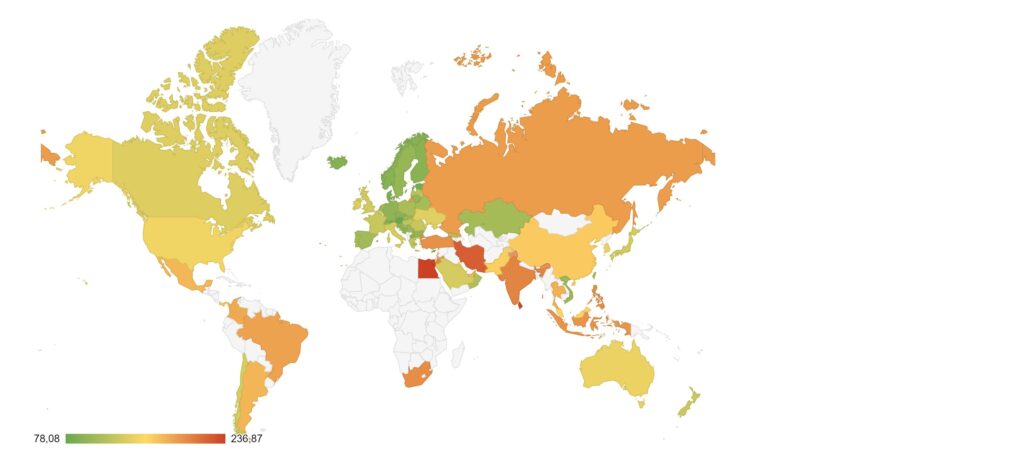
Numbeo’s Traffic Index is a measure based on the efficiency of transport. Included in this index from 2019 are waiting times in traffic, CO2 consumption and the general efficiency of the transport system.
Security
One of the most important criteria for personal well-being in a place is security. On the one hand, important for ourselves and of course also for our technical equipment. Being able to walk the streets alone at night without feeling queasy, or leaving your laptop in the café during a toilet break, is simply priceless.
A good indicator of safety in a country is the Crime Index. This is a key figure between 0 and 100 that looks at corruption, violence, robberies and thefts. All countries with an index above 50 are classified as questionable.
As good as a precaution is sometimes, please don’t let these statistics drive you crazy, just use a good mix of caution and common sense to stay safe on the ground.
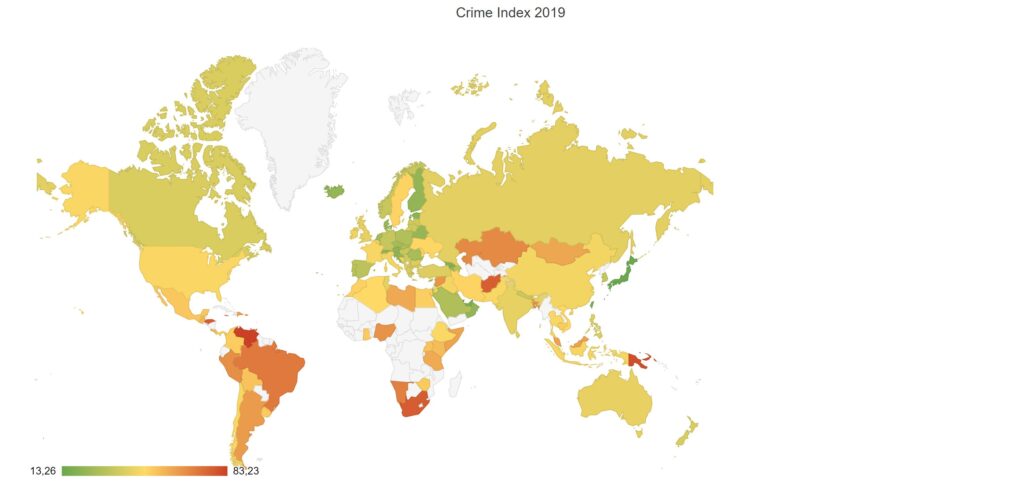
The 2019 Crime Index is based on the number of robberies, burglaries, thefts, drug offences, corruption incidents, violent crimes and discrimination in a country.
Top 25 Hotspots
So you’ve made it this far and hopefully, you have a good idea of which countries and places suit your needs. From the country comparisons, tips from other digital nomads and my own favourites, I’ve finally compiled the top 25 hotspots that are ideal for a longer stay.
For each location, there are a few interesting facts to help you decide and find your way around. The data on internet speed comes from the Net Index database. The cost of a 1-room flat in the centre and a cheap meal in a restaurant is from Numbeo from 2019. The climate data on average temperature and annual precipitation are from Wikipedia, and the data on rainy seasons from this page.
For more information on these and other locations, I highly recommend WebWorkTravel’s Destination Guide with over 60 locations for location-independent entrepreneurs. You can also find coworking spaces and local accommodations through Nomad List, AirBNB and ShareDesk.net.
To make your decision a little easier, here are all the top 25 hotspots in a compact overview, which you can sort according to various criteria. If a hot climate is important to you, then simply sort the hotspots by average temperature. Is internet speed more important to you than a cheap flat? Then look for the places with the fastest download rates.
Bali, Indonesia

A few years ago, Bali was the insider for surfers and backpackers from all over the world. Now the mainstream has arrived at the island and Bali has lost some of its original charms. For digital nomads, Canggu and Ubud are still great places to meet like-minded people, live cheaply and enjoy all kinds of leisure activities. The coworking scene is also growing relentlessly, and the internet is getting better every year. If you prefer something quieter, you can take the ferry to Gili Trawangan or Nusa Lembongan.
1-room flat in the centre: €230.79
Cheap meal in restaurant: 1,74 €
Average temperature: 27 °C
Rainfall per year: 1732 mm
Rainy season: October – April
Internet speed (download rate): 11.81 Mbit/s
SIM card option: Telkomsel, Simpati
Coworking spaces: Hubud (Ubud), Dojo (Canggu)
Bangkok, Thailand
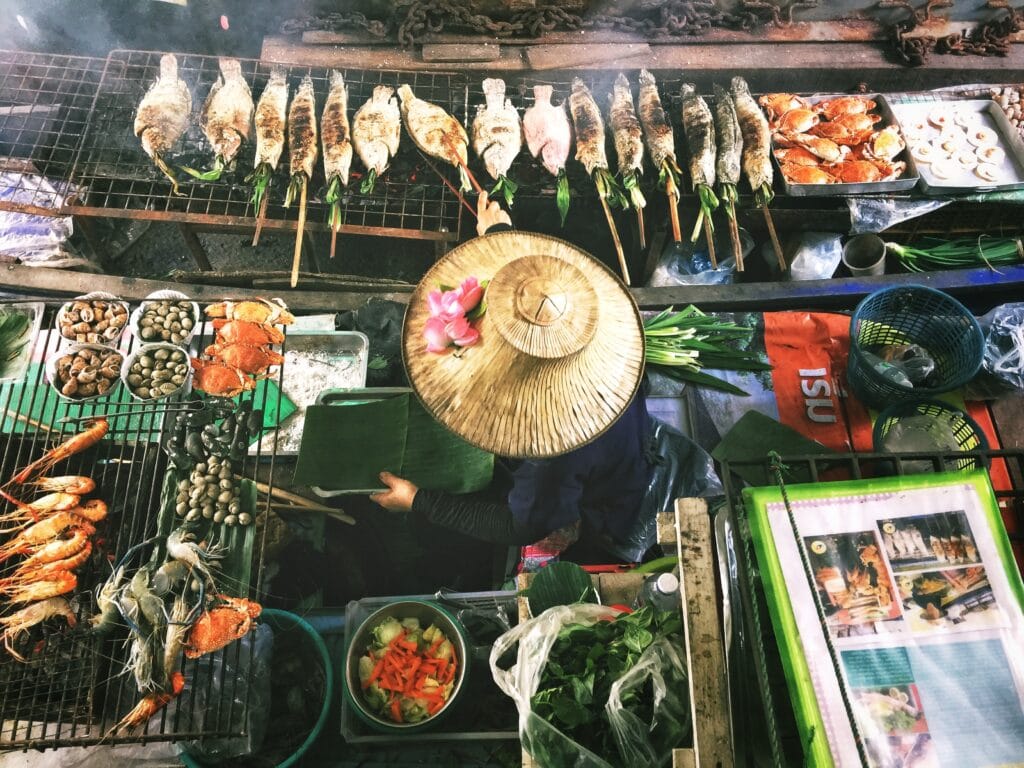
Bangkok really has everything a nomad’s heart desires. There are masses of cheap accommodation, cafés, coworking spaces and always plenty of other digital nomads on site. It certainly won’t get boring in and around Bangkok. The only thing missing is a beach on the doorstep. If you want to stay in Southeast Asia for a long time and have temperatures of 30 degrees all year round, Bangkok is a perfect home base from which other hotspots can be reached quickly.
1-room flat in the centre: €592.91
Cheap meal in a restaurant: €2.21
Average temperature: 29.3 °C
Rainfall per year: 1648 mm
Rainy season: July – October
Internet speed (download rate): 24.95 Mbit/s
SIM card option: TrueMove, AIS
Coworking spaces: Hubba, Pah Space, The Third Place, Launchpad, The Hive, 63 Bangkok
Barcelona, Spain

Plaça Reial in Barcelona ( Wikimedia: Josep Renalias)
One of the European cities of interest to digital nomads. The costs are reasonable by Western European standards and not much needs to be said about the infrastructure and leisure facilities in Barcelona. Flights from Germany are cheap, making Spain’s second-largest city a good alternative for the cold winter months.
1-room flat in the centre: €938.67
Cheap meal in a restaurant: €12.00
Average temperature: 16.5 °C
Rainfall per year: 530 mm
Internet speed (download rate): 42.63 Mbit/s
SIM card option: Yoigo
Coworking Spaces: betahaus, MOB, Coworkidea
Berlin, Germany

Especially in the summer months, our capital becomes a stronghold for digital nomads, artists and other creatives. The thriving start-up scene is infectious, and the many coworking spaces offer plenty of options for working and networking. Another plus for Berlin is the still relatively cheap prices for flats and activities, especially in the districts in the southeast (Kreuzberg, Friedrichshain, Neukölln).
1-room flat in the centre: €864.07
Cheap meal in a restaurant: 8.00 €
Average temperature: 9.73 °C
Precipitation per year: 570 mm
Internet speed (download rate): 35.55 Mbit/s
SIM card option: Congstar, Simyo
Coworking spaces: betahaus, Creative Loft, St. Oberholz, Mobilesuit, Tanterenate
Bocas del Toro, Panama
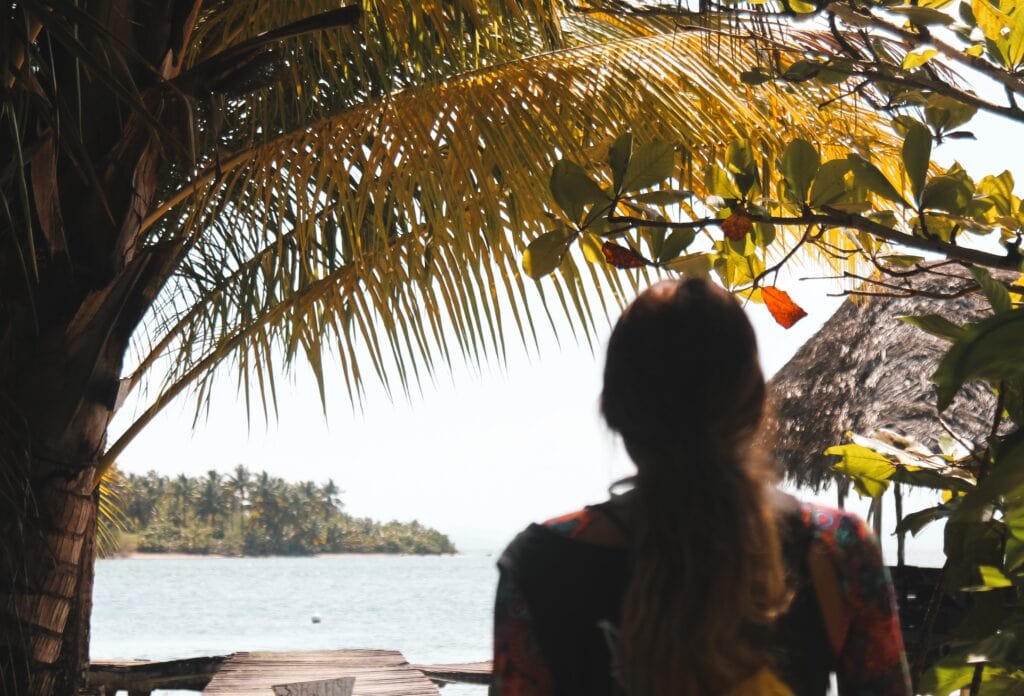
Located near the border with Costa Rica, Bocas on Isla Colón is a popular tourist destination in Panama. Instead of resorts, the small village has simple accommodation for longer stays. All cafés and coworking spaces in Bocas are within walking distance. There are plenty of parties in the evenings and for excursions you can go diving or into the surrounding rainforest.
1-room flat in the centre: €885.91 (Panama)
Cheap meal in a restaurant: 7.63 € (Panama)
Average temperature: 26 °C
Rainfall per year: 3458 mm
Internet speed (download rate): 16.37 Mbit/s
SIM card option: Movistar
Coworking spaces: Ultimo Refugio, Greenhouse Café, Cocovico
Boracay, Philippines
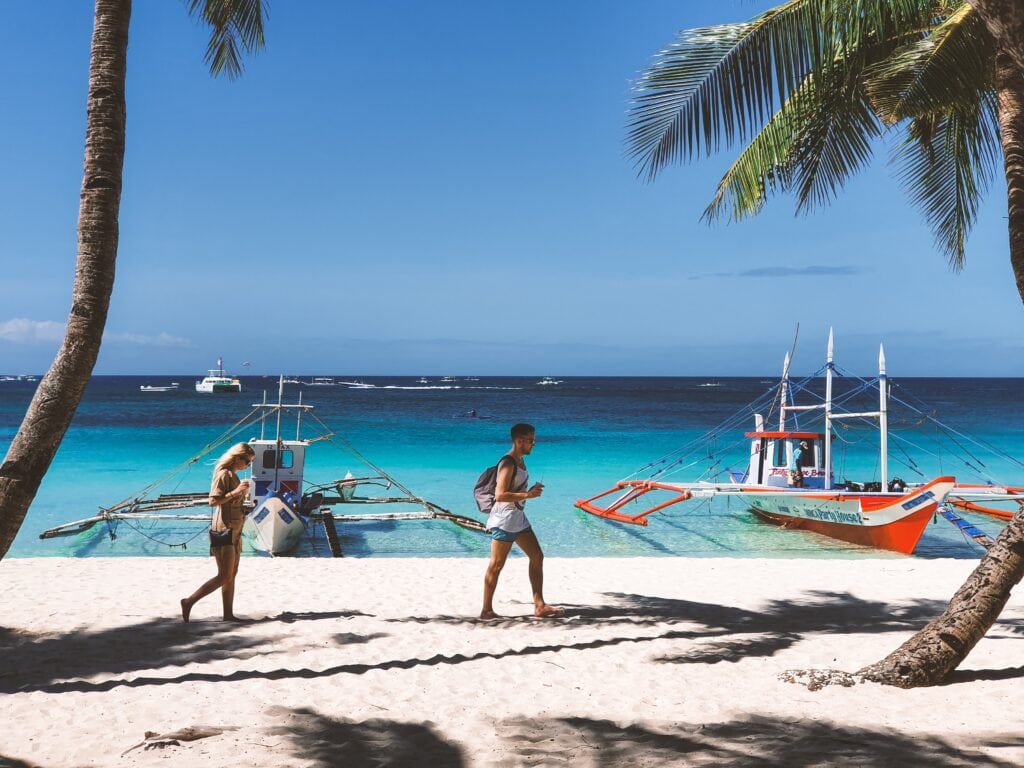
Boracay is an absolute paradise with dream beaches and a vibrant nightlife. In addition to the partygoers, more and more digital nomads are coming to the island to work for a few weeks in a relaxed atmosphere. There are cheap flats and nice cafés, but like everywhere in the Philippines, the internet is quite slow. Nevertheless, Boracay is absolutely recommendable for a few weeks away from the big cities.
1-room flat in the centre: €321.29 (Philippines)
Cheap meal in a restaurant: 3.31 € (Philippines)
Average temperature: 26.8 °C
Rainfall per year: 1629 mm
Rainy season: June – October
Internet speed (download rate): 11.36 Mbit/s (Philippines)
SIM card option: Smart
Coworking Spaces: Lemon Café, Mama’s Café
Budapest, Hungary
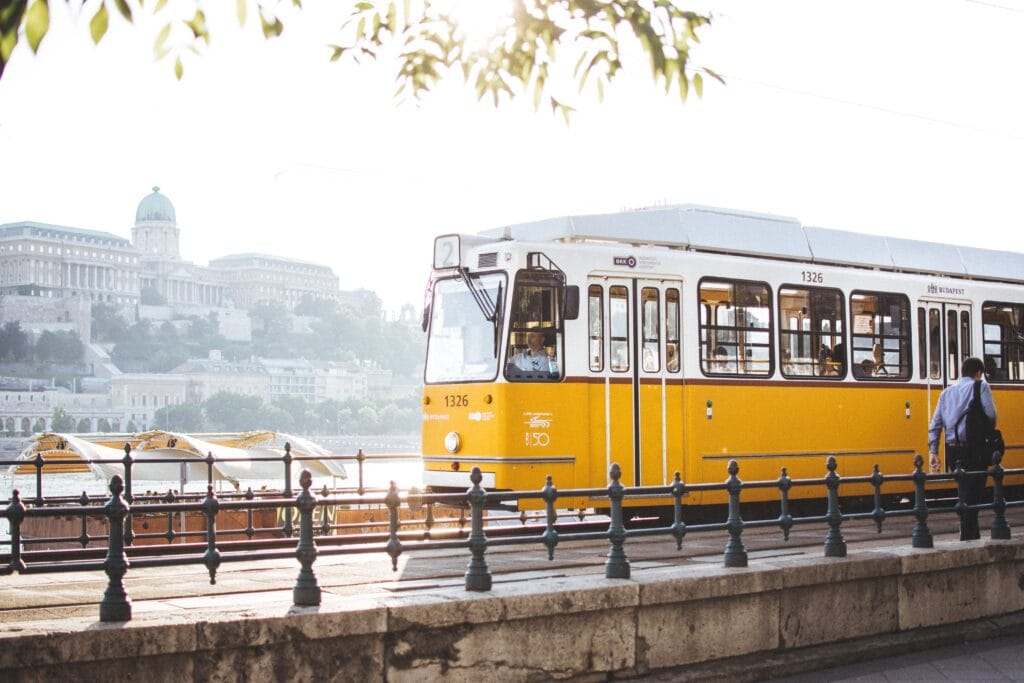
The Hungarian capital is becoming increasingly popular, especially in the summer months. Budapest is known for festivals, an international flair and rich cultural offerings. By European standards, the Eastern European city is cheap, which is why some digital nomads stay there for several months.
1-room flat in the centre: €483.17
Cheap meal in a restaurant: €5.72
Average temperature: 11.3 °C
Rainfall per year: 589 mm
Internet speed (download rate): 56.44 Mbit/s
SIM card option: T-Mobile
Coworking Spaces: Loffice
Buenos Aires, Argentina
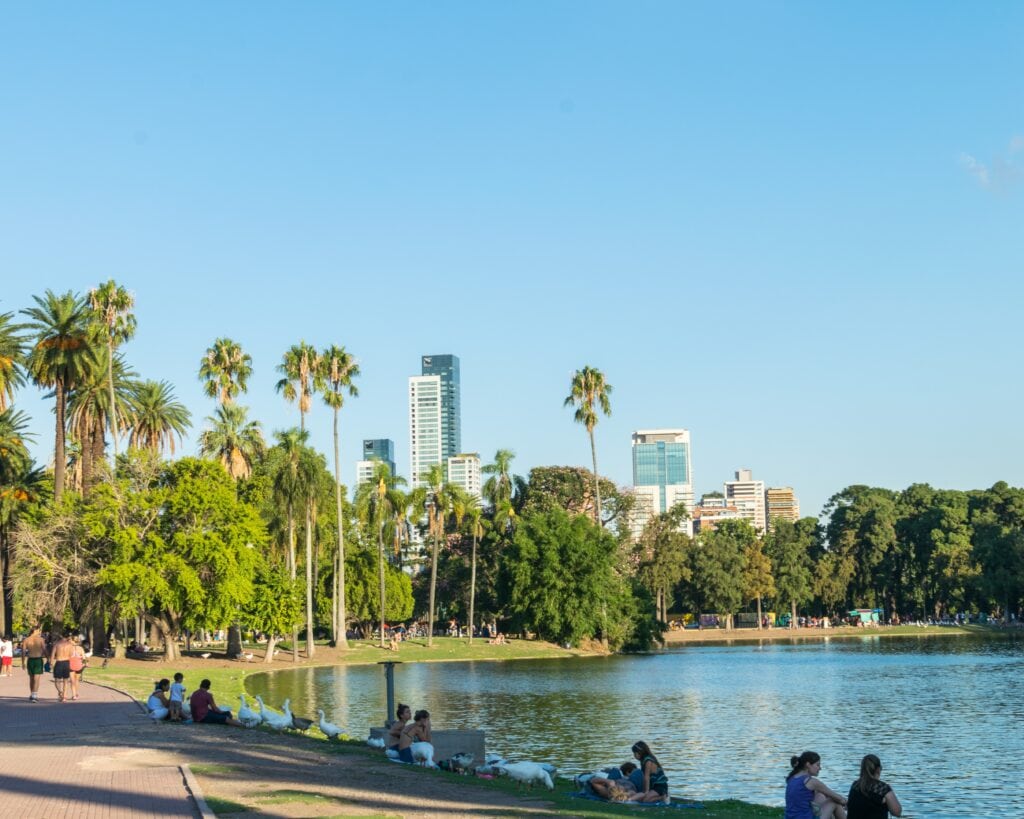
The metropolis in eastern Argentina has more to offer than 16-lane roads and juicy steaks. Buenos Aires is popular because of its relatively low cost for a city of its size. Besides many digital nomads who spend the winter here and congregate in the Palermo district, you’ll find tango dancers and cosy cafés in Buenos Aires.
1-room flat in the centre: €285.47
Cheap meal in a restaurant: €6.43
Average temperature: 17.72 °C
Rainfall per year: 1214 mm
Internet speed (download rate): 13.65 Mbit/s
SIM card option: Claro
Coworking Spaces: Urban Station, Cespedes, Workstation BA, Area Tres, Urban Station, Areatres
Chiang Mai, Thailand
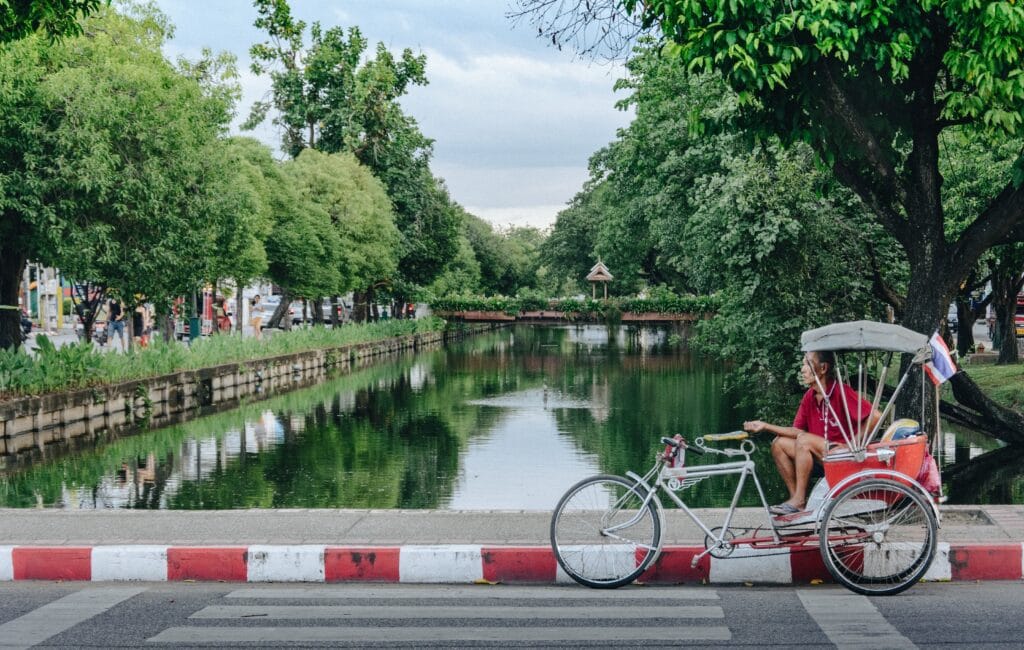
The city in the north of Thailand can be described without exaggeration as the metropolis for digital nomads. Especially in the dry season from November, when it gets cold in Germany, you will meet many well-known bloggers and online entrepreneurs here. Chiang Mai has many coworking spaces, cafés, cheap flats, nature, perfect temperatures and delicious food. Only one thing is missing and that is the beach.
1-room flat in the centre: €305.84
Cheap meal in restaurant: €1.39
Average temperature: 26 °C
Rainfall per year: 1130 mm
Rainy season: July – October
Internet speed (download rate): 24.95 Mbit/s
SIM card option: TrueMove, AIS
Coworking Spaces: PunSpace, TCDC, Mana Space, CAMP
Ho Chi Minh City, Vietnam
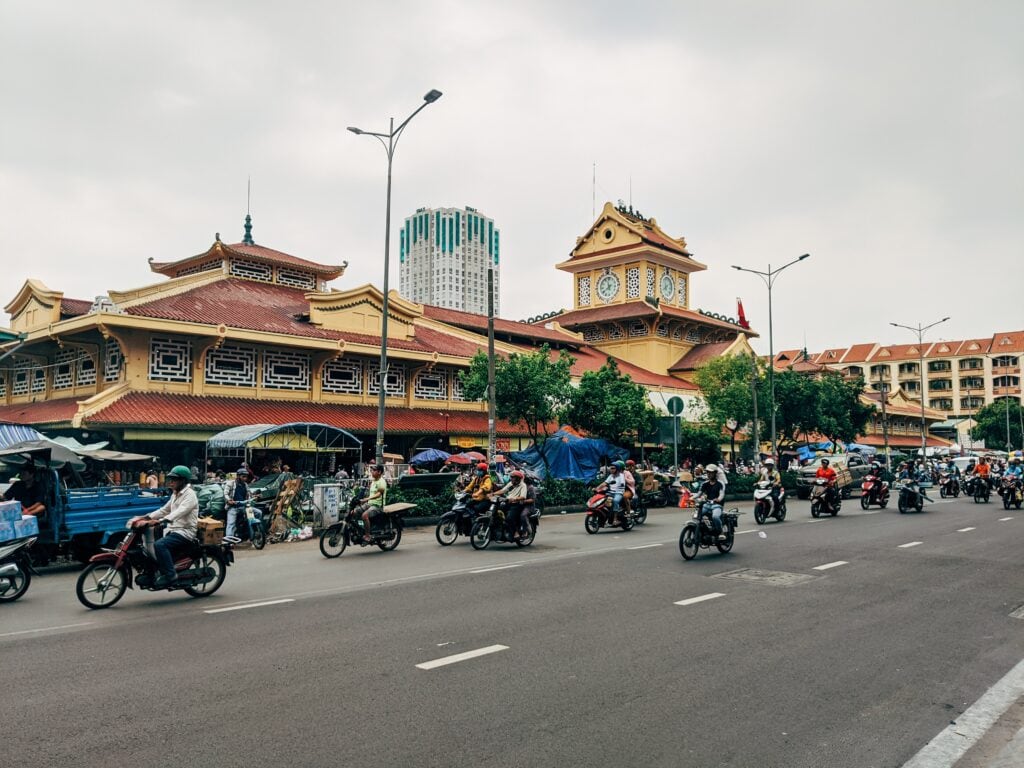
HCMC (or Saigon) is probably the most developed city in Vietnam. The locals are very open and usually speak good English. There is also a rapidly growing scene of creatives and entrepreneurs. There is definitely no shortage of cheap accommodation and coworking spaces. You don’t have to look far for leisure activities, either.
1-room flat in the centre: €384.24
Cheap meal in a restaurant: €1.90
Average temperature: 28 °C
Rainfall per year: 1931 mm
Rainy season: June – August
Internet speed (download rate): 20.65 Mbit/s
SIM card option: MobiFone, Viettel
Coworking Spaces: Work Saigon, Saigon CoWorking, M2C Café, La Habana
Cape Town, South Africa
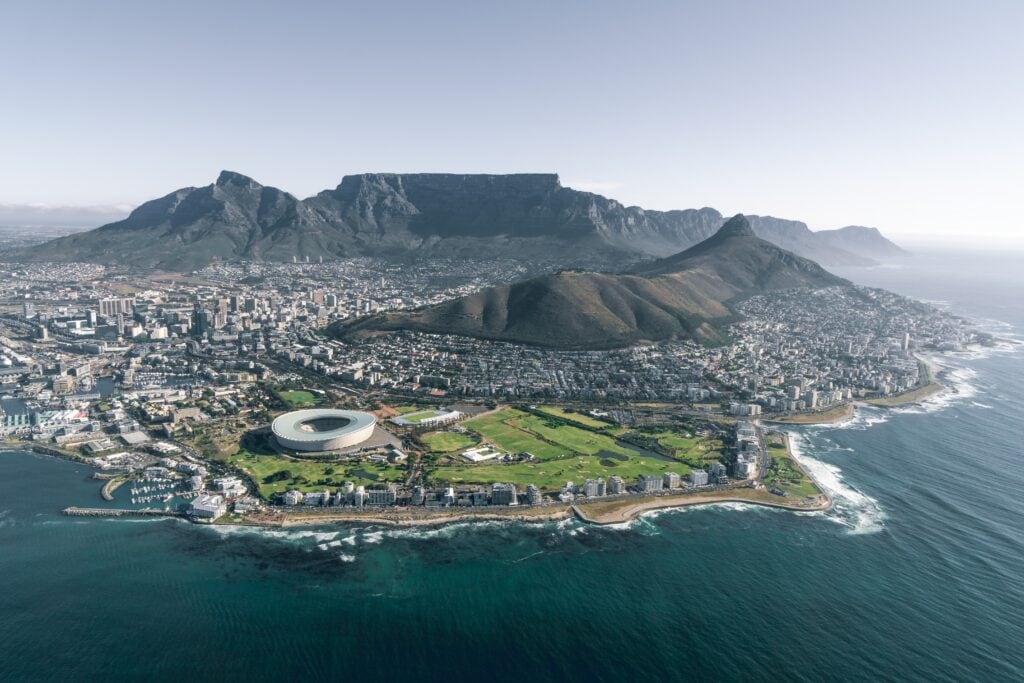
Cape Town is the perfect mix of African culture and European influence. The leisure facilities (especially kite surfing) are huge, and there are also plenty of affordable flats and coworking spaces. Cape Town has a reputation for high crime, although I didn’t have any problems myself, as long as I didn’t hang out recklessly in the wrong corners.
1-room flat in the centre: €657.25
Cheap meal in a restaurant: 7,39 €
Average temperature: 16.2 °C
Rainfall per year: 515 mm
Internet speed (download rate): 18.66 Mbit/s
SIM card option: Cell C
Coworking Spaces: 88mph, Daddyo, Bandwith Barn
Kathmandu, Nepal
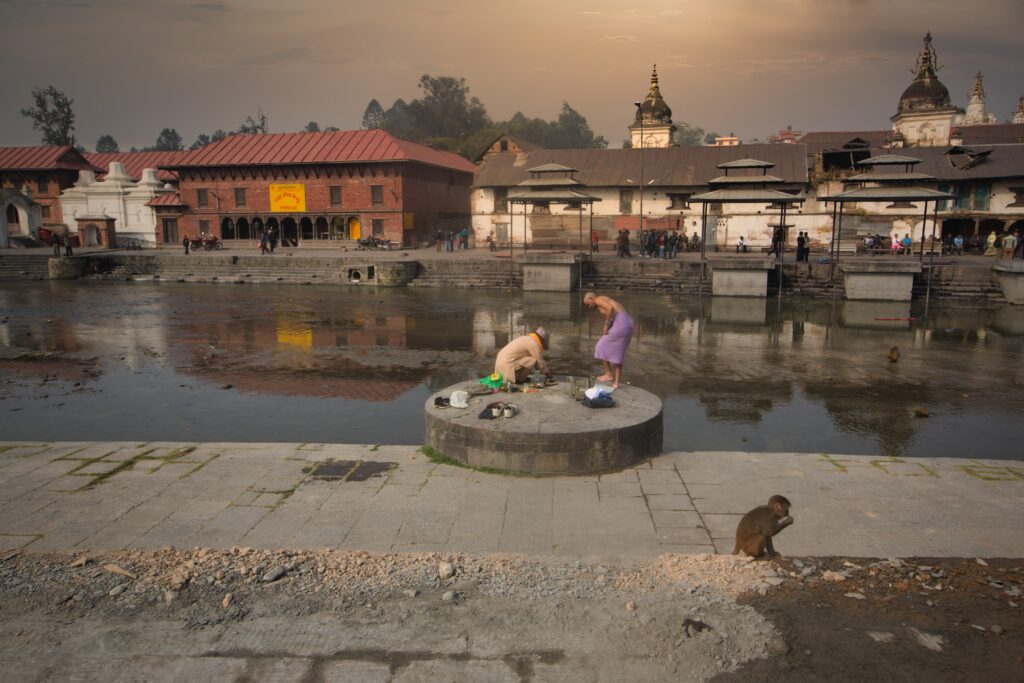
The capital of Nepal is still more of an insider than a tourist stronghold. The admittedly chaotic and dirty city attracts adventure-seekers who make trips from here towards Mt Everest. Kathmandu is extremely cheap and has many small cafés that are good places to work. The vibe in the city is great and ensures that you will make connections in no time.
1-room flat in the centre: €151.70
Cheap meal in restaurant: €2.00
Average temperature: 18.5 °C
Rainfall per year: 1455 mm
Rainy season: June – September
Internet speed (download rate): 9.11 Mbit/s
Coworking Spaces: The Platform Inc, Work Around
Koh Lanta, Thailand
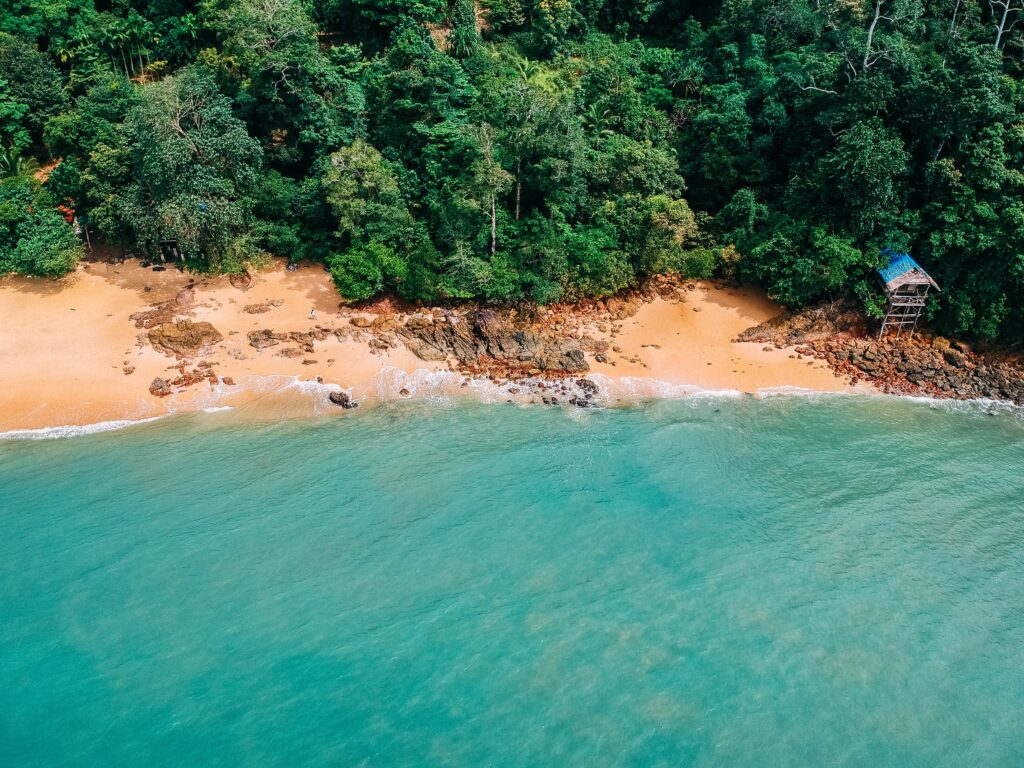
If you like it relaxed and want to work really productively, then the island in the southwest of Thailand is just the right place. Koh Lanta has beautiful beaches, limited nightlife and plenty of great cafés and restaurants. With the Kohub, there is also a super coworking space. Prices are generally a bit higher in the south of Thailand than in the north, but still relatively cheap.
1-room flat in the centre: €325.71 (southern Thailand)
Cheap meal in a restaurant: 2.78 € (Southern Thailand)
Average temperature: 27.9 °C
Rainfall per year: 1960 mm
Rainy season: July – October
Internet speed (download rate): 24.95 Mbit/s
SIM card option: TrueMove
Coworking Spaces: Kohub
Koh Pha Ngan, Thailand

The island where the infamous Full Moon Party takes place once a month is an absolute paradise in the south of Thailand. Even though prices have risen considerably in recent years, you can still find inexpensive beach huts. You can work in many cafés and the newly opened Koh Space. Otherwise, Koh Pha Ngan offers a lot of action in the evening, if you like it.
1-room flat in the centre: €325.71 (Southern Thailand)
Cheap meal in restaurant: 2,78 € (Southern Thailand)
Average temperature: 27.9 °C
Rainfall per year: 1960 mm
Rainy season: July – October
Internet speed (download rate): 24.95 Mbit/s
SIM card option: TrueMove
Coworking spaces: Koh Space, Crave Bar, Boom’s Cafe
Las Palmas, Gran Canaria
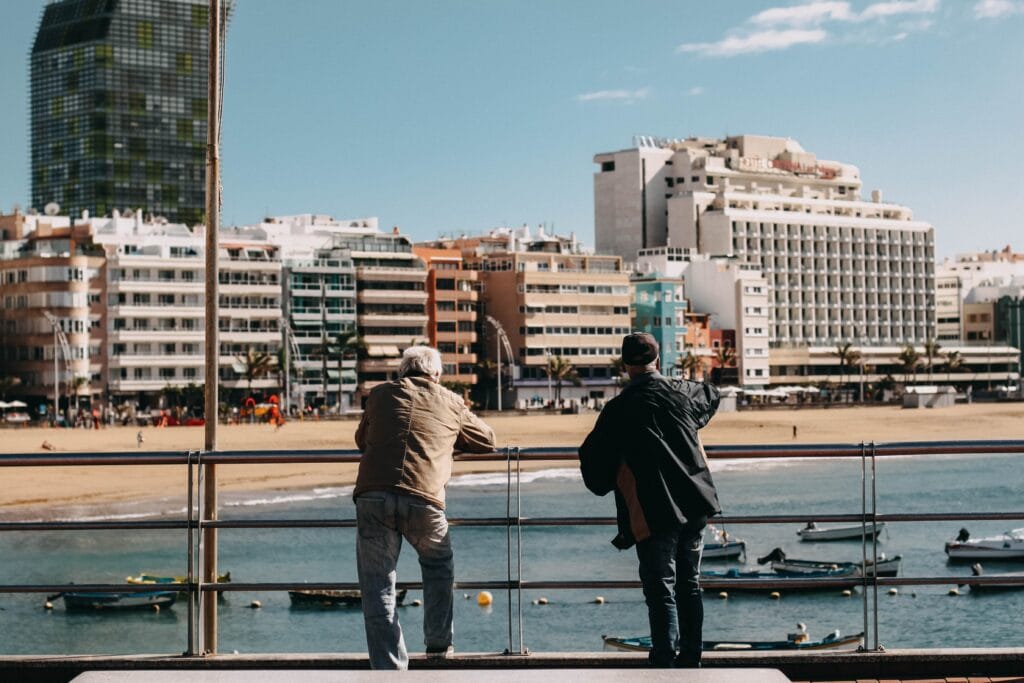
The Balearic and Canary Islands, such as Tenerife and Majorca, are best known among families, party holidaymakers and pensioners. But digital nomads have also taken a liking to the mild climate and proximity to Germany. Las Palmas is easy to reach, relatively cheap and equipped with an ever-growing nomad scene, coworking spaces and events.
1-room flat in the centre: €606.67
Cheap meal in restaurant: €10.00
Average temperature: 25 °C
Rainfall per year: 174 mm
Internet speed (download rate): 42.63 Mbit/s
SIM card option: Pepephone
Coworking Spaces: CoworkingC
Lisbon, Portugal
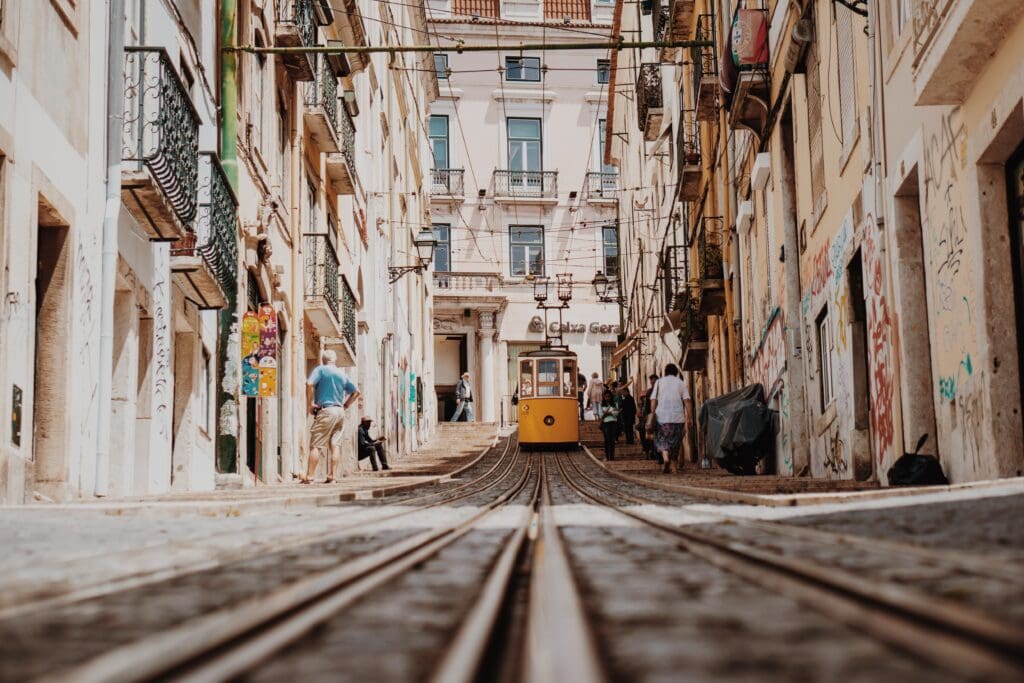
The Portuguese capital is one of the cheapest destinations in Western Europe and a good choice for digital nomads. Flights from Germany are cheap, making Lisbon a popular getaway, especially in spring and autumn. Many startups and location-independent entrepreneurs congregate in Lisbon’s coworking spaces, making for a great atmosphere.
1-room flat in the centre: €867.03
Cheap meal in a restaurant: €8.50
Average temperature: 17.5 °C
Rainfall per year: 774 mm
Internet speed (download rate): 31.15 Mbit/s
SIM card option: Vodafone
Coworking Spaces: Liberdade229, Coworklisboa, Coworklab
Medellin, Colombia
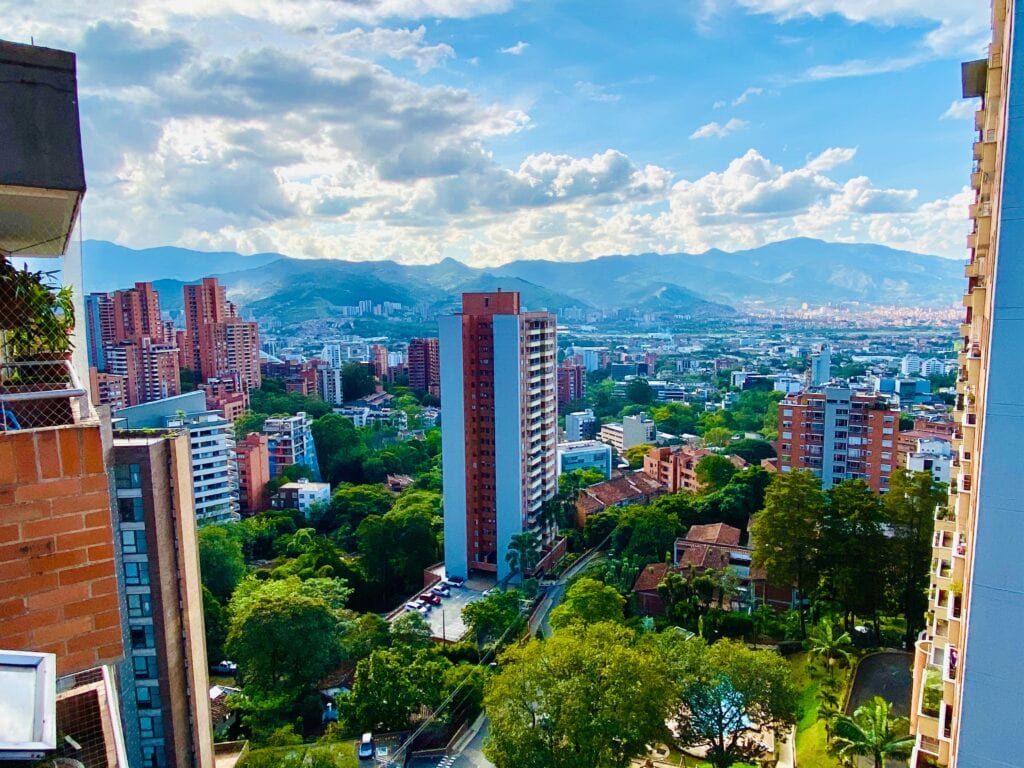
Medellin used to be considered one of the most dangerous cities in the world, dominated by the drug war. Today, the second-largest city in Colombia is a real insider tip for location-independent entrepreneurs.
Medellin has pleasant temperatures, a low cost of living and a rapidly growing creative scene with many digital nomads.
1-room flat in the centre: €234.32
Cheap meal in a restaurant: €3.41
Average temperature: 22.3 °C
Rainfall per year: 1673 mm
Rainy season: May – September
Internet speed (download rate): 12.25 Mbit/s
SIM card option: Clara
Coworking Spaces: Espacio, Atom House
Mexico City, Mexico
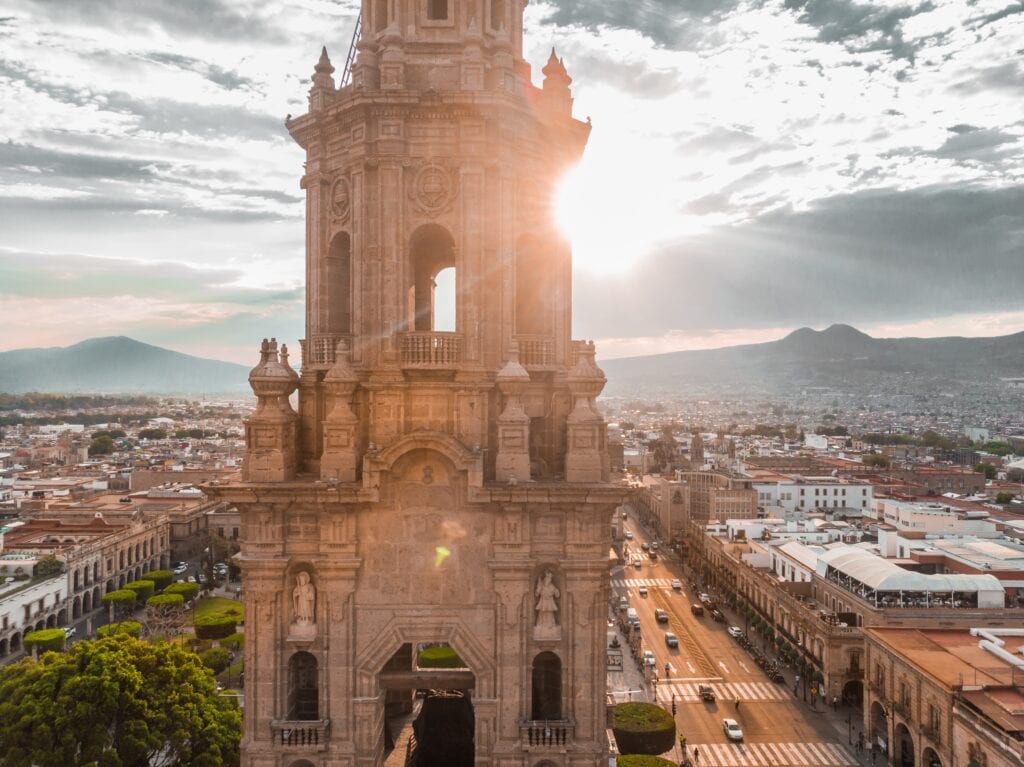
Unlike small Mexican villages on the coast, the capital is anything but “laid back”. Life is raging here. The possibilities for going out, eating and other activities are endless. In addition to cosy cafés, Mexico City also has an increasing number of coworking spaces and digital nomads who stay here for longer periods of time. If you avoid certain neighbourhoods in Mexico City, you won’t have to worry about your safety, either.
1-room flat in the centre: €490.62
Cheap meal in a restaurant: €4.17
Average temperature: 23.5°C
Rainfall per year: 754 mm
Internet speed (download rate): 19.38 Mbit/s
SIM card option: Telcel
Coworking Spaces: Urban Station, Centraal
Prague, Czech Republic
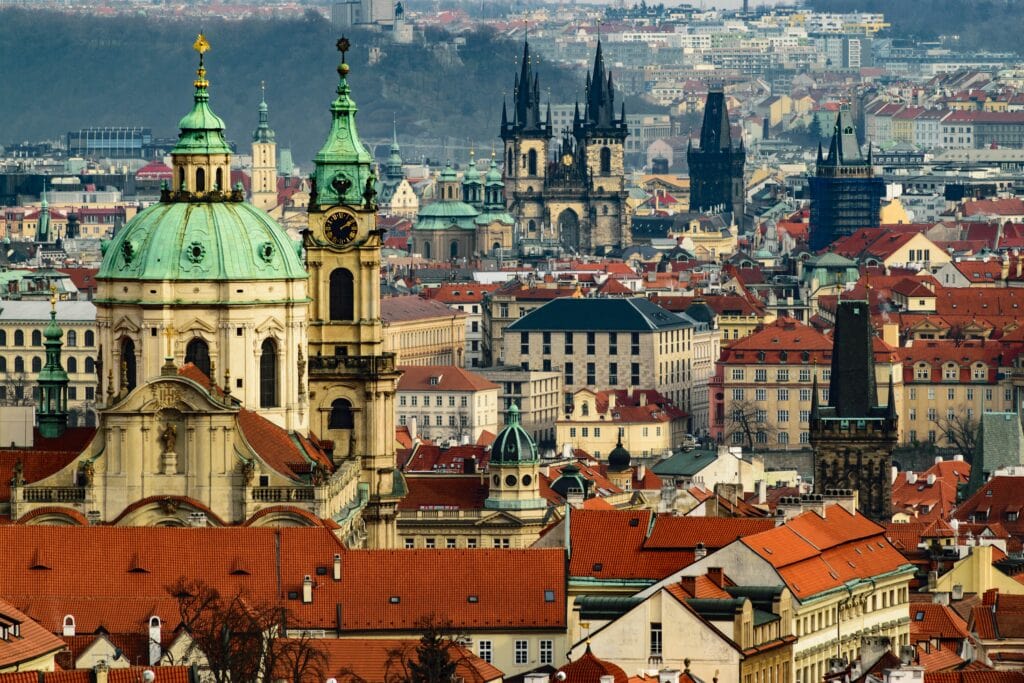
The capital of the Czech Republic consists of a historic centre with many bars, cafés and restaurants and on the other hand it also has a mature coworking culture. Unfortunately, the days when Prague was a cheap destination are over. Especially in the centre, prices have reached German standards. Nevertheless, Prague is absolutely recommendable in summer.
1-room flat in the centre: €710.07
Cheap meal in a restaurant: €5.86
Average temperature: 7.9 °C
Precipitation per year: 525 mm
Internet speed (download rate): 31.64 Mbit/s
SIM card option: T-Mobile
Coworking spaces: Impact Hub, Atmoska, Coffice, Locus, TheHUB Prague
San Francisco, USA

Due to its proximity to Silicon Valley and its creative vibe, San Francisco attracts entrepreneurs from all over the world. The infrastructure with many options for coworking and the year-round good weather are perfect. However, San Francisco is also by far the most expensive city among the most popular hotspots for digital nomads.
1-room flat in the centre: €2,945.84
Cheap meal in a restaurant: €13.13
Average temperature: 14.5 °C
Rainfall per year: 524 mm
Internet speed (download rate): 46.90 Mbit/s
SIM card option: AT&T, Verizon
Coworking Spaces: NextSpace, PariSOMO, Founders Den, Citizen Space, Rocket Space, Dolores Labs
San Juan del Sur, Nicaragua
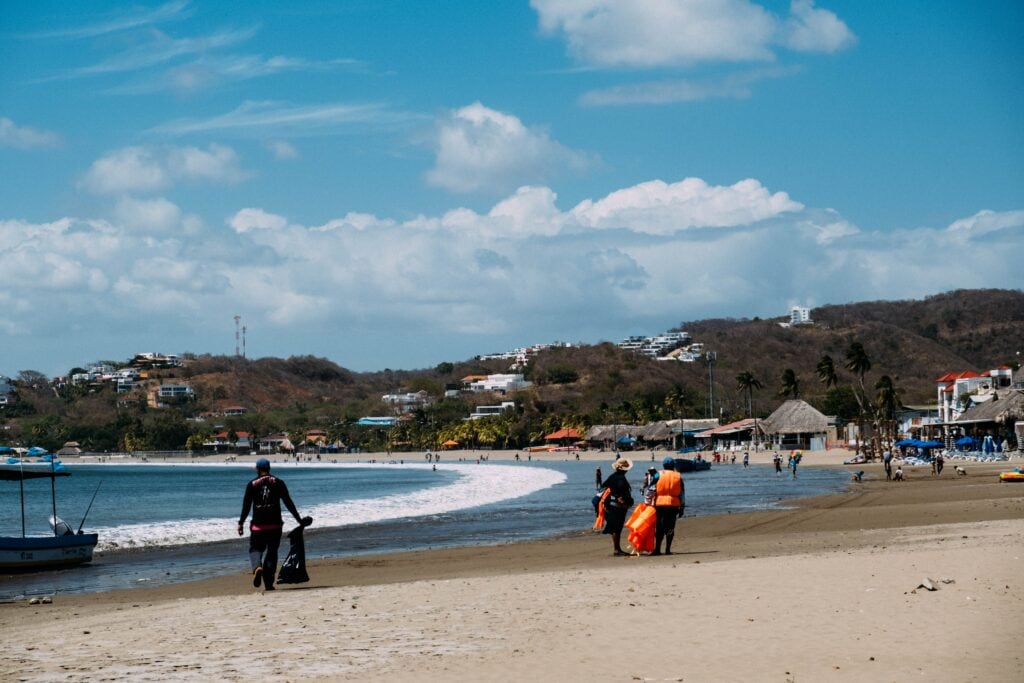
The small port town in Nicaragua has a breathtaking panorama of beach, cliffs and small houses with thatched roofs. As a cheap alternative to neighbouring Costa Rica, San Juan del Sur offers many leisure activities and a few cafés where you can use the rather mediocre internet.
1-room flat in the centre: €612.54
Cheap meal in a restaurant: €8.81
Average temperature: 26.6 °C
Rainfall per year: 1439 mm
Rainy season: May – September
Internet speed (download rate): 9.45 Mbit/s
Coworking Spaces: Banana Hamacas, Barrio Café, Iguana Beach Bar
Santiago de Chile, Chile
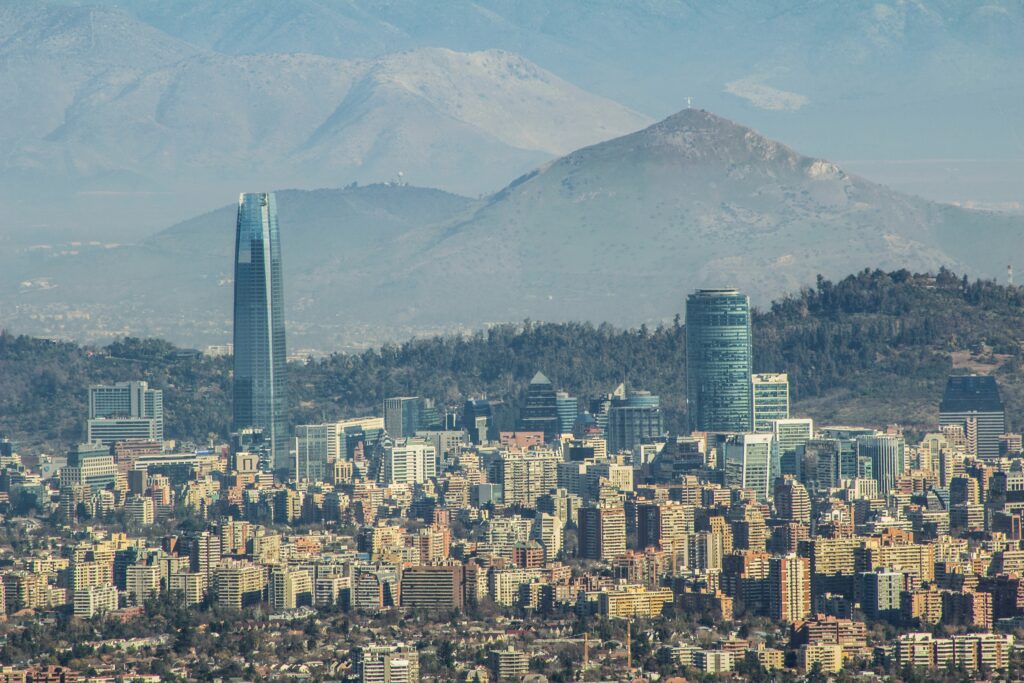
The capital of Chile, located in the Andes, is known for its very good infrastructure and the surrounding snow-capped mountains. Due to its good location and low cost of living, Santiago is not only popular with tourists, but also with digital nomads. Coworking spaces are available, and the internet speed is excellent by South American standards.
1-room flat in the centre: €443.18
Cheap meal in a restaurant: €7.93
Average temperature: 14.2 °C
Rainfall per year: 282 mm
Internet speed (download rate): 24.14 Mbit/s
SIM card option: Entel
Coworking Spaces: Connectas, CoworkingLatam, Moviestar Innova Center
Tirana, Albania
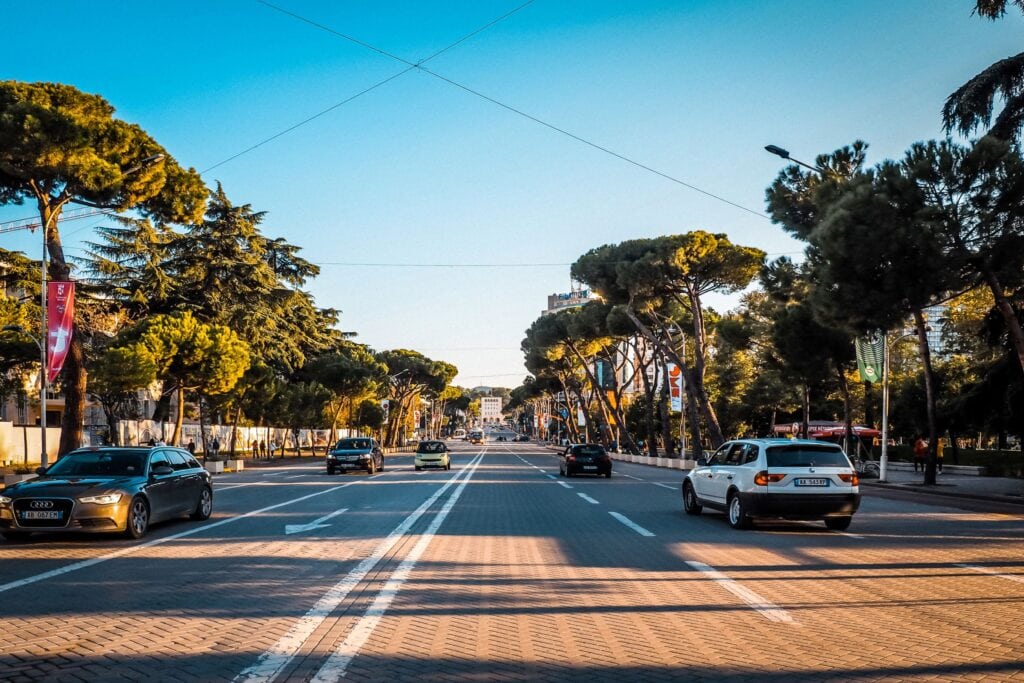
A newcomer in the digital nomad space, but not to be overlooked. Tirana draw nomads with 300+ days of sun a year, cheap delicious food, friendly locals and fast internet. Plus, you find it just a stone throw from Central Europe. The county may be small, but you find everything there, from break taking mountain landscapes to century old culture to secluded beaches with crystal clear water.
1-room flat in the centre: €418.70
Cheap meal in a restaurant: €5.68
Average temperature: 21.5 °C
Rainfall per year: 1266 mm
Internet speed (download rate): 31.64 Mbit/s
SIM card option: Vodafone Albania
Coworking Spaces: Nomad Island
Taghazout, Morocco
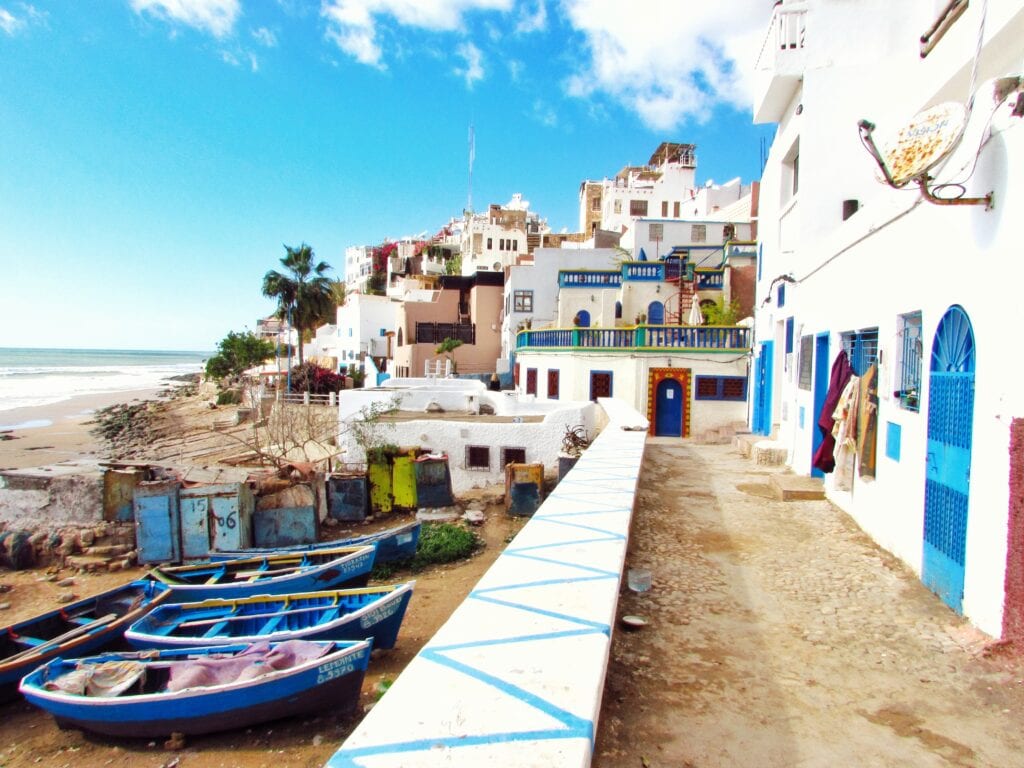
This coastal town in Morocco is popular with surfers and anyone looking to escape the German winter for a few weeks. The best way to reach Taghazout is via nearby Agadir, which is served by Ryanair. Taghazout is cheap and offers a relaxed atmosphere, making it a good option for the winter months. The only drawback is the unreliable internet.
1-room flat in the centre: €372.78 (Morocco)
Cheap meal in restaurant: 3.21 € (Morocco)
Average temperature: 18.3 °C
Rainfall per year: 250 mm
Internet speed (download rate): 15.39 Mbit/s
SIM card option: INWI
Coworking Spaces: SunDesk
Tallinn, Estonia
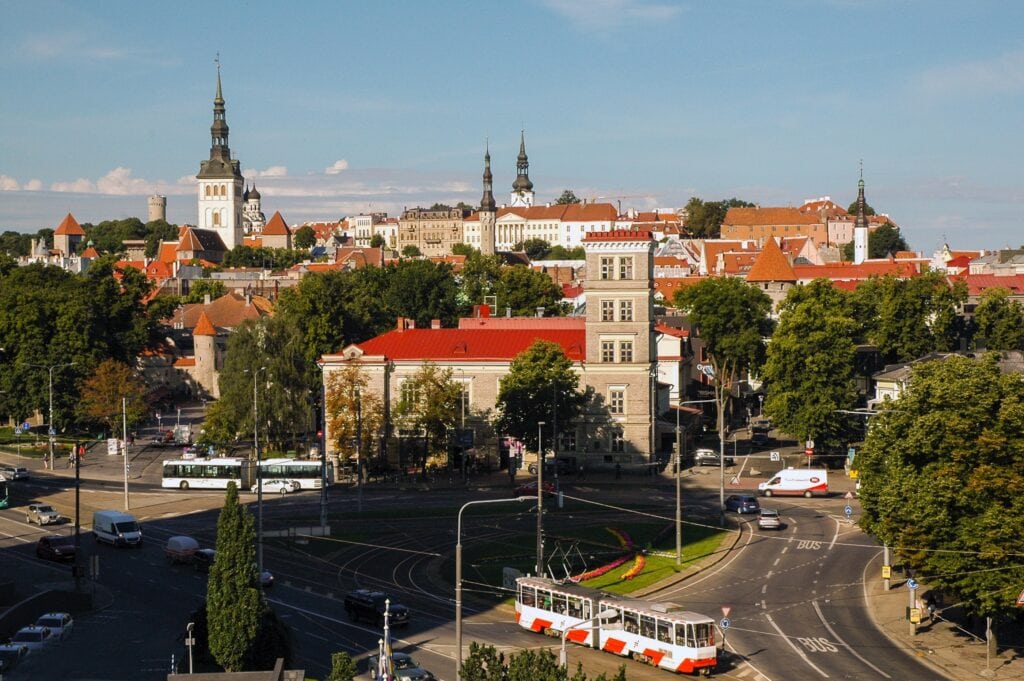
Not many places in Eastern Europe can be called strongholds for digital nomads. Tallinn, however, is well on its way there, at least in the summer months. The World Heritage Site offers a good mix of historical old town and wild nightlife. The super infrastructure, fast internet and, last but not least, the e-residency programme ensures that more and more digital nomads are coming to Tallinn.
1-room flat in the centre: €504.69
Cheap meal in restaurant: 8,00 €
Average temperature: 5.9 °C
Rainfall per year: 618 mm
Internet speed (download rate): 41.46 Mbit/s
SIM card option: Tele2
Coworking Spaces: Kohvik Komeet, Kompott, F-hoone, Garage48
Wow, you really made it to the end of the location guide for digital nomads. So, have you found the right place for you? Now it’s time to book your flight to your dream destination as soon as possible and, with the help of the community of other web workers, make your goals a reality.
Which hotspot is your favourite? Do you have any other tips for us?
If you know of any other cool destinations where it’s good to live and work, I’d love to hear from you. Your comments on mistakes or suggestions for improving this guide are also very welcome.
I hope you make the most of your freedom and don’t wait too long to get on the plane.


